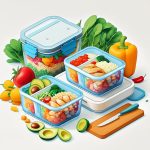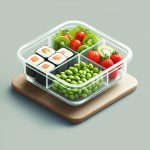Ever wished you had more energy, felt better in your clothes, and just generally felt amazing? This isn’t some magic trick; it’s about making smart food choices. For more tips on establishing healthy habits, check out this helpful resource: healthy eating habits. This guide isn’t about crazy diets, it’s about a simple shift towards eating cleaner that can completely change how you feel. We’ll walk you through real people’s amazing transformations, showing exactly how they did it, and give you the tools to do the same. Get ready to ditch the sluggishness, boost your mood, and discover the incredible results of eating well – it’s easier than you think!
Before and After Healthy Eating: Your Amazing Transformation Starts Now
Ready to feel incredible? Let’s explore the power of healthy eating and how it can dramatically change your life. It’s not just about fitting into smaller jeans; it’s about feeling energized, vibrant, and truly happy in your own skin. This isn’t a fad diet; it’s a journey towards a healthier, happier you, with sustainable nutrition habits.
Understanding Your Starting Point: The “Before”
Before embarking on this incredible journey, let’s acknowledge where you might be right now. Many people begin with habits that, while comforting in the moment, don’t serve them in the long run. This might include relying on processed foods, skipping meals, or using food to cope with stress or emotions. It’s common to experience low energy, poor sleep, digestive problems, and perhaps even feelings of frustration or discouragement. This is your “before,” but it’s also the crucial foundation for your transformation. Don’t judge yourself; simply acknowledge where you are to confidently move forward.
The “After”: A Gradual but Remarkable Shift
The transformation you’ll undergo isn’t a magical overnight fix. It’s a gradual unfolding, a beautiful process of growing healthier and happier, day by day, week by week, month by month. You might notice a boost in energy within just a few days of making some changes. Within a couple of weeks, you might experience improved sleep and digestion. Over the next few months, you’ll likely see positive changes in your weight, skin clarity, and overall well-being. It’s a ripple effect, with each improvement building upon the next. The journey may not always be easy, but the progress is incredibly rewarding, and completely achievable.
Your Step-by-Step Guide to a Healthier Lifestyle
This is a lifestyle change, not a quick fix. It’s about building sustainable habits that will serve you for years to come, so let’s ditch those unhealthy patterns.
Step 1: Take Stock of Your Current Habits: Honestly assess your eating patterns. What do you typically eat? When do you eat? What triggers your food choices – stress? Boredom? Once you understand your current habits, you can set realistic, achievable goals. Baby steps often lead to giant leaps!
Step 2: Make Gradual, Sustainable Swaps: Don’t try to change everything at once. That’s a recipe for overwhelm and failure. Instead, gradually introduce whole, unprocessed foods into your diet. Start by swapping sugary sodas for water or unsweetened tea. Replace processed snacks with fruits, vegetables, or a small handful of nuts. Small, consistent changes add up to significant improvements over time.
Step 3: Embrace Mindful Eating: This is key! Pay attention to your body’s signals. Eat slowly, savor each bite, and really taste your food. Ask yourself: Am I actually hungry, or am I eating out of boredom, stress, or emotion? Learning to differentiate between physical hunger and emotional hunger is powerful.
Step 4: Address Emotional Eating: We all have emotional triggers. Identify yours. Are you reaching for comfort food when you’re stressed, sad, or lonely? Find healthier ways to cope, such as exercise, meditation, spending time in nature, or connecting with loved ones. These activities can offer similar comfort and satisfaction without the negative consequences of overeating.
Step 5: Create a Sustainable Routine: This isn’t a sprint; it’s a marathon. Building lasting habits takes time and commitment. Incorporate regular exercise into your routine, find healthy ways to manage stress, and schedule regular check-ups with your doctor or a registered dietitian. Their guidance can help you create a personalized plan and stay on track.
Real-Life Transformations: Inspiring Stories of Success
Many individuals have shared their inspiring journeys of transformation. Their stories underscore the power of commitment and illustrate that a healthier lifestyle is attainable. These narratives demonstrate that sustainable change is definitely within your reach.
One example is Sarah, who struggled with chronic fatigue and digestive issues for years. After adopting a clean eating approach, focusing on whole, unprocessed foods, Sarah experienced a significant improvement in her energy levels and digestion. She also lost weight and gained confidence.
Another example is Mark, a busy professional who regularly relied on fast food due to time constraints. By implementing meal prepping strategies and making healthier choices, Mark was able to improve his energy levels, focus, and overall well-being. He also found that he was saving money by cooking at home more often.
Addressing Questions and Concerns
It’s crucial to understand that there’s no one-size-fits-all approach to healthy eating. Everyone’s body is unique, and what works for one person might not work for another. The optimal balance of macronutrients (carbohydrates, proteins, and fats), specific dietary needs, and the role of supplements are all complex areas that are still under investigation. The best way to create a personalized plan is to consult with healthcare professionals, like a registered dietitian or your doctor, to tailor a strategy that suits your unique requirements and goals.
The Ups and Downs: A Balanced Perspective
Change takes time, effort and, honestly, often some bumps along the way. Here’s a realistic view of both the challenges and the incredible rewards that await you:
| Challenge | Reward |
|---|---|
| Overcoming cravings and temptations | A surge in energy and vitality |
| Finding time to prepare healthy meals | Improved digestion and reduced bloating |
| Navigating social events with unhealthy food | Better sleep and an uplifted mood |
| The initial cost of healthier ingredients | Long-term cost savings on healthcare |
| Managing emotional eating | Improved self-esteem and increased body confidence |
Remember, your path to a healthier you is unique. Celebrate every milestone, acknowledge any setbacks as learning opportunities, and remember that support is always available. You’ve got this!
How to Overcome Emotional Eating While Transitioning to Clean Eating
Key Takeaways:
* Recognize emotional eating patterns.
* Develop mindful eating habits.
* Implement stress management techniques.
* Gradually transition to clean eating.
* Seek professional support if needed.
Ready to ditch emotional eating and embrace clean eating? Let’s dive in. This isn’t about perfection; it’s about progress. You can do this!
Understanding Your Relationship with Food
Before we tackle how to overcome emotional eating while transitioning to clean eating, let’s examine your current eating habits. What triggers your emotional eating? Stress? Boredom? Loneliness? Keeping a food journal can be incredibly helpful. Note what you eat, when, and how you feel. Identify patterns. This self-awareness is crucial.
Transitioning to Clean Eating: A Gradual Approach
Clean eating doesn’t mean deprivation. It’s about nourishing your body with whole, unprocessed foods. Start small. Don’t try to change everything at once. The goal is to maintain a balanced nutritional intake.
Step 1: Swap, Don’t Strip. Replace processed snacks with fruits and vegetables. Swap sugary drinks for water or herbal tea. One swap at a time – you’ve got this!
Step 2: Mindful Munching. Pay attention to your body’s hunger cues. Eat slowly. Savor each bite. Are you truly hungry, or are emotions driving your food choices? This awareness is key.
Step 3: Stress Management. Emotional eating often stems from stress. Explore stress-reducing activities. Consider yoga, meditation, or spending time in nature. Discover what works for you.
Step 4: Seek Support. Don’t hesitate to reach out for help. A therapist or registered dietitian can provide personalized guidance and support. They’re on your team.
Strategies for Managing Emotional Eating
- Mindful Eating: Pay attention to the taste, texture, and smell of your food. Eat slowly and savor each bite. 1
- Distraction Techniques: Redirect your attention when cravings hit. Call a friend, go for a walk, or listen to music.
- Self-Compassion: Be kind to yourself. Setbacks happen. Don’t beat yourself up. Just keep moving forward. It’s about progress, not perfection.
Sample Meal Plan (Adjust to your needs and preferences)
| Meal | Monday | Tuesday | Wednesday | Thursday | Friday |
|---|---|---|---|---|---|
| Breakfast | Oatmeal with Berries | Greek Yogurt with Fruit and Nuts | Scrambled Eggs with Spinach and Whole-Wheat Toast | Smoothie with Protein Powder and Leafy Greens | Whole-Wheat Toast with Avocado and Everything Bagel Seasoning |
| Lunch | Salad with Grilled Chicken or Chickpeas | Leftovers from Dinner | Soup and Salad (Lentil soup with a side salad) | Quinoa Bowl with Roasted Vegetables | Veggie Wrap with Hummus and Avocado |
| Dinner | Baked Salmon with Roasted Vegetables (Broccoli, Brussels Sprouts, Sweet Potatoes) | Chicken Stir-fry with Brown Rice | Lentil Soup with Whole Grain Bread | Turkey Meatloaf with Steamed Green Beans | Vegetarian Chili with a dollop of Greek yogurt |
Before & After Transformations (Illustrative Examples)
Remember, every journey is unique. These are just examples of potential positive changes you could experience.
Before: Low energy, frequent cravings for sweets, emotional eating during stressful situations, bloating after meals, difficulty sleeping.
After: Increased energy throughout the day, reduced cravings for sugary foods, improved digestion with less bloating, better sleep quality, and more stable mood.
Remember, this is a journey, not a race. Be patient with yourself. You are capable of amazing things.
Clean Eating Success Strategies for Busy Professionals
Key Takeaways:
- Strategic meal planning and batch cooking save significant time.
- Prioritizing whole foods and minimizing processed options is crucial.
- Mindful eating combats emotional eating and promotes healthier choices.
- Gradual transitions, not drastic overhauls, yield lasting results.
- Consistency and realistic goals are vital for long-term success.
The Before: Recognizing Your Starting Point
Let’s be honest. Before embracing clean eating success strategies for busy professionals, your life probably involved grabbing fast food, skipping meals, or relying on unhealthy convenience items. Sound familiar? You felt sluggish, tired, and maybe even battled digestive issues. Stress levels were high; energy levels were low. You weren’t alone. Many professionals experience this before discovering the power of mindful, whole-food eating.
The After: A Transformation Takes Shape
Now imagine this: You wake up feeling energized. Your digestion is smooth. You’re sharper, more focused at work. You’re not constantly battling cravings. This isn’t magic; it’s the result of consistent, smart choices. Think of it as a gradual climb, not a sudden sprint to the top of a mountain. Embracing lifestyle medicine is key.
Step-by-Step Guide to Clean Eating for Busy Professionals
-
Assess Your Current Habits: Honestly evaluate your current eating patterns. What are your go-to unhealthy meals? What triggers your unhealthy eating habits? Setting small, achievable goals at the beginning is important. Don’t overwhelm yourself.
-
Gradual Transition: Don’t try to change everything overnight. Swap one processed snack a day with fruit or vegetables. Gradually replace sugary drinks with water. Swap white bread for a whole grain alternative. Start slowly. Small changes add up.
-
Master Mindful Eating: Pay attention to your hunger cues. Eat slowly, savor each bite. Put your phone down while eating. Try it. It’s surprisingly effective.
-
Tackle Emotional Eating: Identify your emotional triggers. Find healthy ways to manage stress – exercise, meditation, spending time in nature. What helps you relax?
-
Sustain the Momentum: This isn’t a quick fix, it’s a lifestyle change. Schedule regular check-ins to assess progress. Don’t give up. Celebrate your successes.
Recipes and Resources
While specific recipes can be found online easily, here are some go-to meal ideas:
- Breakfast: Overnight oats prepared in advance, smoothies with protein powder and greens, whole-wheat toast with avocado and egg.
- Lunch: Large salads with grilled chicken or chickpeas, leftover dinners, quinoa bowls with roasted vegetables.
- Dinner: Sheet pan meals (chicken and vegetables), slow cooker meals (soups, stews), stir-fries.
Addressing Concerns and Misconceptions
Clean eating isn’t about perfection; it’s about progress. Remember, individual needs vary, so consult a healthcare professional for personalized guidance. There’s no one-size-fits-all solution.
It’s also a misconception that clean eating is expensive. By planning meals and buying in bulk, you can actually save money compared to eating out or buying processed foods.
Clean Eating Meal Prep for Weight Loss and Energy Boost
Key Takeaways:
- Clean eating meal prep simplifies healthy eating, saving time and promoting weight loss.
- Focusing on whole foods fuels your body efficiently, boosting energy levels.
- Sustainable lifestyle changes involve gradual shifts and mindful eating practices.
- Addressing emotional eating habits is crucial for long-term success.
- Personalized plans and professional guidance enhance results.
Understanding Your Starting Point
Before diving into clean eating meal prep for weight loss and energy boost, let’s assess your current eating habits. What are your typical meals? Are you experiencing fatigue, bloating, or other health issues? Identifying these patterns is step one. Think of it as mapping your terrain before embarking on a journey. Honesty is vital here.
The Transformative Power of Whole Foods
Switching to clean eating meal prep isn’t about deprivation; it’s about nourishing your body. This means filling your plate with nutrient-rich foods—fruits, vegetables, lean proteins, and whole grains. Imagine your body as a high-performance machine—it needs the right fuel to run optimally. Processed foods are like low-grade gasoline—they might get you going, but they won’t sustain you. According to the Academy of Nutrition and Dietetics, whole foods provide essential vitamins, minerals, and antioxidants that support overall health and well-being.
A Gradual Transition: Small Changes, Big Impact
Don’t try to overhaul your diet overnight. Start gradually. Maybe swap one processed snack for a piece of fruit. Then, slowly introduce more whole foods into your meals. Think of it as a staircase, not a cliff jump. A realistic approach increases your chances of success as you alter your metabolic rate.
Step-by-Step Guide to Clean Eating Meal Prep
- Assessment: Honestly evaluate your current diet and identify areas for improvement.
- Planning: Create a weekly meal plan incorporating whole foods. Include recipes you enjoy.
- Preparation: Dedicate some time each week to prepping ingredients (chopping veggies, cooking grains).
- Mindful Eating: Pay attention to your hunger cues. Eat slowly, savor your food.
- Emotional Eating Strategies: Learn healthy coping mechanisms for stress and cravings.
- Maintenance: Stay consistent with your meal prep and healthy habits. Regular check-ins with a healthcare professional will ensure you stay on track.
Addressing Common Concerns
Many people worry about the time commitment involved in clean eating meal prep. However, even small changes make a difference. Start with batch cooking a few staple items, and gradually expand your repertoire as you become more comfortable. Remember, consistency is key.
To save time, consider using pre-cut vegetables, pre-cooked grains, or meal prep delivery services.
Before & After: Real-Life Transformations
Before: John, a 35-year-old office worker, struggled with excess weight, low energy, and frequent cravings for sugary snacks. He often skipped breakfast and relied on fast food for lunch.
After: After adopting a clean eating meal prep routine, John started preparing healthy breakfasts and lunches in advance. He noticed a significant improvement in his energy levels, lost weight, and experienced fewer cravings.
Recipes and Resources
- Overnight Oats: Combine rolled oats, milk (dairy or non-dairy), chia seeds, and your favorite toppings (fruit, nuts, seeds) in a jar and refrigerate overnight.
- Quinoa Bowls: Cook quinoa in bulk and combine it with roasted vegetables, beans, and a healthy dressing.
- Sheet Pan Meals: Roast chicken or tofu with a variety of vegetables on a single sheet pan for an easy and nutritious meal.
-
Clean Eating Meal Prep – All Nutritious. (n.d.). https://allnutritious.com/clean-eating-meal-prep/ ↩
- Mini Bento Boxes For Packing Kids Snacks And Small Meals - December 27, 2025
- Small Bento Box Makes Packing Lunch Easy and Fun Again - December 26, 2025
- Adult Bento Box Lunch Ideas For Quick Healthy Portable Options - December 25, 2025










